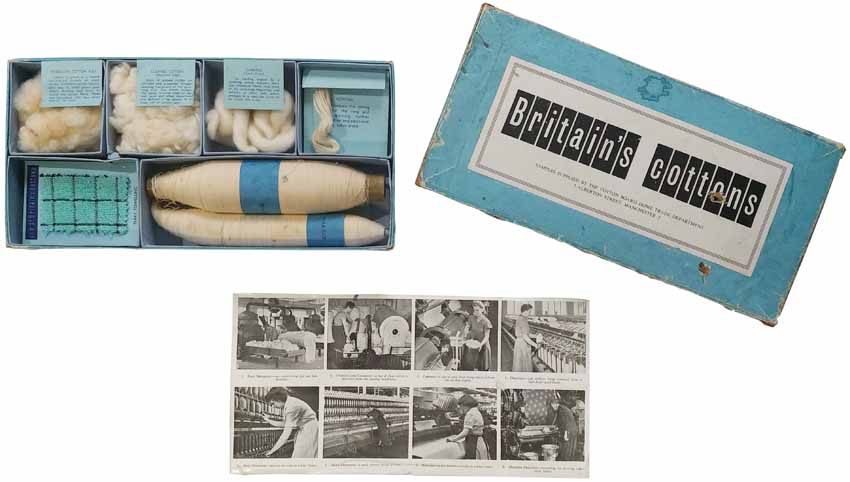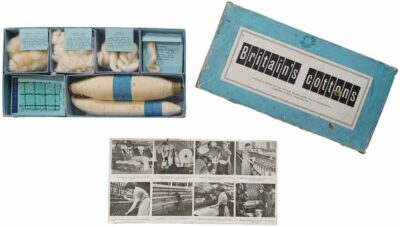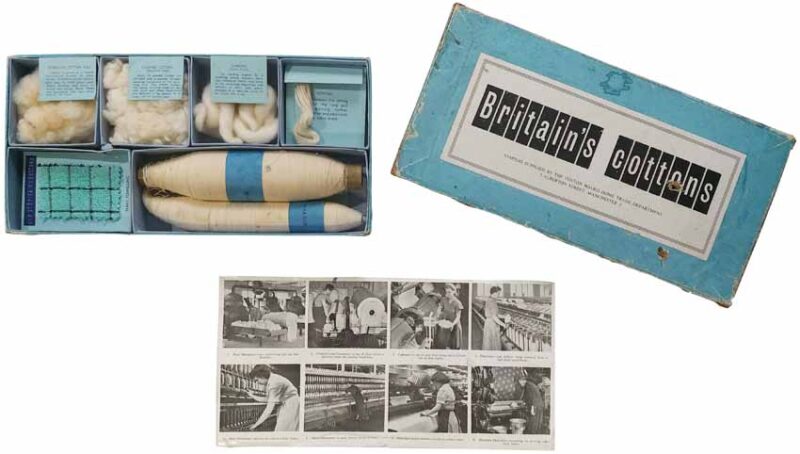
Anon.
Britain’s Cottons: Vintage Sample Box by the Cotton Board Home Trade Department.
Manchester, circa 1960
- $175
Boxed samples supplied by the Cotton Board Home Trade Department, containing cotton samples in seven formats at different stages of production, thirteen unique fabric swatches made from said cotton, each of the samples and swatches accompanied by a text description on a blue card. Together with the original photographic pictorial insert printed recto and verso to illustrate industrial cotton processing and provide statistics to entice commercial buyers. Original blue cardboard box measuring approximately 32 x 16 x 4 cm, with six box compartments within it serving to neatly separate and display the contents, and paper label to front. Wear and pierce marks to box, otherwise in excellent condition, its contents well preserved, an intact and complete item. Samples show cotton at various stages, including: An American Cotton Boll, Cleaned Cotton (Scutcher Lap), Carding (Card Silver), Slubbing, Roving, a Mule Cop of weft yarn ready for use in a loom shuttle, a Ring Tube of weft yarn suitable for warp in the weaving process, 13 finished woven fabric swatches, most of which are dyed. Statistics printed on the inserted leaf, reveal that in the year 1960, the United Kingdom exported cotton goods amounting to a value of £63,000,000 while local consumers purchased approximately 1,800 million square yards of cotton textiles. Further listing all the countries from where raw cotton and the like was imported, the United Kingdom purchased 822 million lbs. From this, the finished product of cotton textiles exported to Africa, Australia and New Zealand, America, and Western Europe, amounted to 327 million square yards exported. An astounding 222,720 workers were employed in the United Kingdom Cotton Industry, mostly in Lancashire, but also including the neighbouring districts of Yorkshire, Derbyshire and Cheshire. The Cotton Board was an organisation to oversee the organisation, research, marketing and promoting the cotton textile industry mainly based in Lancashire and Glasgow. A voluntary Cotton Board was set up in 1940 to "promote the welfare of the industry by internal reorganisation, by the development of export trade, scientific research, propaganda and other means." The board was given statutory status from 1948 to 1972 under the Industrial Organisation and Development Act 1947, and was known in its last years as the Textile Council. The Board had equal representation from industry and trades unions, with four members each, plus three independent members. It was given the power to levy up to £250,000 a year from the industry. Its headquarters was in Manchester, together with the "Colour, Design and Style Centre", which became the public face of the board. Between 1956 and 1962, the Cotton Board organised promotions to try and increase sales of Lancashire cotton within the UK, using generic marks, particularly the slogan "Buy British Cottons" - as seen on the leaf in the present display box. Its initiatives included new methods for utilising labour, recruitment and training, the encouragement of collaboration within the cotton industry, and design innovations. British fashion designs and fabrics were showcased at national and international exhibitions, ranging from an exhibition on the history of the cotton mills and a display of 1960s children's clothing to soft furnishing promotions at large stores and national fashion shows. Initiated by the Cotton Industry Act 1959, the Board engaged in a major attempt to reorganise the cotton industry, which entailed "the scrapping of machinery and compensation for redundant workers in the industry, which was carried through with great success and great expedition". Regrettably, a combination of reduced consumer demand, poor marketing and cheaper Commonwealth imports during the period of reorganisation created, a reduction of confidence in the industry, according to the Board's chairman Lord Rochdale. This both reduced the amount asked for by industry and invested by the government and resulted in mac
More from Voyager Press Rare Books & Manuscripts
Photograph Album = New Zealand Shipping Company (NZSC) Through the Panama Canal
PHOTO ALBUM New Zealand, Panama Canal, New Brunswick, 1921-1923. Album of photographs taken by a young and enthusiastic merchant mariner employed by the New Zealand Shipping Company (NZSC) on a refrigerated cargo steamer, featuring a voyage through the Panama Canal to the Canadian Maritimes and the American East coast. Contains 93 gelatin silver print photographs mounted onto brown cardstock leaves, not necessarily in chronological order. Oblong 8vo. string-tied album measuring approximately 17,5 x 15 x 2 cm, brown cloth boards, with some manuscript captions. Photographs vary in size, the smallest measuring approximately 5,5 x 2,5 cm, and the largest 14,5 x 8,5 cm. Indication of moisture to boards, fading to a scant few images, otherwise in Very Good Condition, a primary source visual capsule of the seaman's working life onboard a merchant ship and a helpful resource for identifying NZSC employed crew members. With captioned dates spanning from June 1921 to June 1923, this album features images of New Zealand, the Panama Canal, and life at sea, as seen and enjoyed by a working member of a crew the S.S. Piako, a refrigerated cargo liner then recently built by the New Zealand Shipping Company. With its trade route, the photographer had the opportunity to make several voyages across the South Pacific, through the Panama Canal - of which he includes several photographs, New Brunswick, New York and Virginia, in North America. He also visited Australia.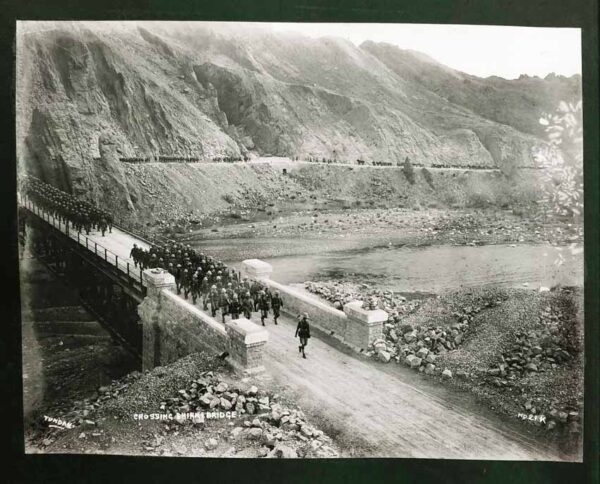
Photo Album of Waziristan Campaign 1936-1939 – Primary Source Photographs By Tundan of Kabul – King’s Royal Rifle Corps Marching Through Khyber Pakhtunkhwa
Tundan (Photographer) Waziristan, 1936-1939. Two albums of photographs taken by professional Afghani photographer known simply as Tundan, while accompanying the King's Royal Rifle Corps through the passes and plains of Khyber Pakhtunkhwa (Norther Waziristan Agency) during the Waziristan Campaign of 1936-1939. Contains 44 gelatin silver print photographs, most with embedded inscribed numbers and photographer's name, some with further caption, mounted onto black cardstock leaves, not necessarily in sequential order. Photographs measure approximately 20 x 15 cm. Contained in two oblong 8vo. string-tied albums with black cardstock boards, each measuring approximately 25 x 20 x 2 cm. Chips to album covers, varying degrees of fading and mirroring to some images, otherwise in Very Good Condition, a remarkable photographic chronicle providing detailed insight into the vast terrain that some 60,000 soldiers marched and defended. From the earliest stages of the demonstrative military march in October-November 1936, to the expansion of base camps for the numerous reinforcement troops and more elaborate operations in 1937, the images demonstrate the sheer magnitude of maintaining a presence and protecting British interests in the Northwest Frontier during heightened opposition. The Waziristan Campaign (1936-1939) was a series of operations by a combined British and Indian force intended to restore Imperial hegemony in the Waziristan region of the Northwest Frontier of British India. The campaign began in response to a revolt incited by the Waziri leader Ghazi Mirzali Khan Wazir, nicknamed the Fakir of Ipi by the British, who had launched a jihad against British rule for their intervention in a religious conversion and planned marriage of a young Indian girl. The photographs indicate that two separate columns marched north to reach Kohat. Those who had gone east from Idak to Bannu, would travel further east to Latambar Pass before going north to Kohat. The others would go directly from Idak to Datta Khel, Thal, then Kohat. B. Tundan, a professional photographer from Kabul, is best remembered for his work performed directly alongside the British troops during the Waziristan Campaign of 1936-1939, photographing not only the soldiers and convoys, but capturing recognizable scenes, structures such as forts and bridges, as well as villages along the way. Tundan and his associates, along with occasional photographic rivals, produced several pictures showing the King's Royal Rifle Corps regiment running its paces in 1936, during the Waziristan Revolt. Tundan is credited for capturing the vast majority of photographs of the Northamptonshire's 76-mile march from Razmak to Bannu in late October to early November 1936, a historic event which is well represented in the present albums. At the time, his photographs served as a guide to troops travelling through and patrolling the area, as the soldiers carried them around in their own personal albums for reference. Approaching a century later, today the photographs serve as a superb primary source visual chronicle of the historic campaign in a region which was so rarely seen in pictures in any event. The photographer most often identified himself only by his name 'Tundan' on the photograph, however in one instance herein, he inscribes 'Tundan Razani', suggesting that Razani was the location of his workshop.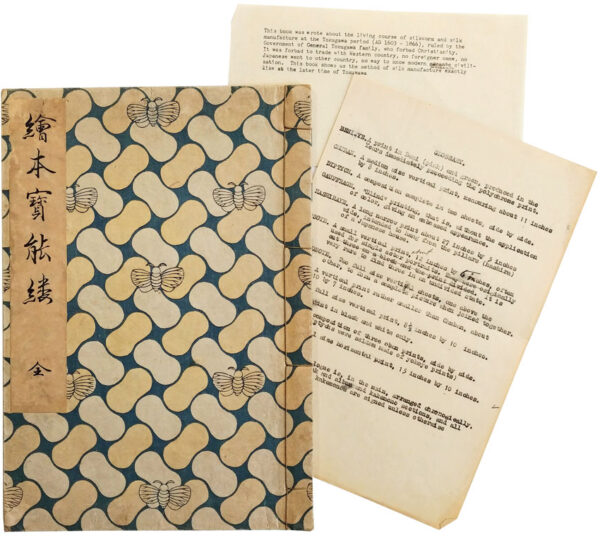
Kaiko yashinaigusa – Cultivation of Silk Worms
Kitao Shigemasa and Katsukawa Shunshô A complete series of 12 Edo or Tokugawa Period Chuban Japanese Woodblock Prints on sericulture (silk production), bound in book form and first produced in 1772 (Meiwa 9/An'ei 1) by Kitao Shigemasa. Designed collaboratively with Katsukawa Shunsho with six prints by Kitao Shigemasa and six by Katsukawa Shunshô. It was reprinted in 1776, 1786 and then later in 1916 (as here). Very pleasingly bound in book form with silk cloth covers showing silk moths. The prints show the twelve stages of silk production, comprising: Laying eggs on a sheet of paper; Picking mulberry leaves to feed larvae; Transferring grown silkworms to other bamboo mats and feeding them; Re-activating worms after sleep; Feeding larvae with mulberry leaves; Placing cocoons on trays; Arranging male and female moths to lay eggs; Silkworm moth flying after hatching cocoon; Hand-spinning thread from cocoons in a pan of boiling water; Stretching silk floss on wooden posts; Spinning silk; Weaving silk on loom Ukiyo-e artists Shigemasa ?? ?? (1739-1820) and Shunsho ?? ?? (1726-1793) were best known for geisha paintings, haikai (poetry), and shodo (calligraphy). Shigemasa primarily created books, though he did produce separate prints. He may have been a pupil of Nishimura Shigenaga but little else is known about his education. Katsukawa Shunsho, Shigemasa's collaborator, was "one of the unquestionably great masters of Ukiyo-e, outstanding as painter and print-designer". A student of Miyagawa Shunsui (also known as Katsukawa), Shunsho founded his own eponymous sub-school. Kitao Shigemasa "was unusual among ukiyo-e artists because he was self-taught. His family ran a bookshop, and the young Shigemasa probably learnt his skills from studying illustrations in books sold in the family shop. His first works gained recognition during the late 1750s. Extant early works are benizuri-e and yakusha-e, but his principal output is in book illustration, which he practiced throughout his career and which became the speciality of the Kitao school, of which he was the founder.His students included Kitao Masanobu, Keisai Masayoshi (1764-1824) and Kubo Shunman." (Oxford Art online) Shigemasa was the eldest son of the bookseller and publisher Suharaya Mohei whose premises were located in Nihonbashi. He was initially self-taught but later became a student of Nishimura Shigenaga (1697-1756). Shigemasa's early work showed the influence of Suzuki Harunobu (ca. 1725-1770), and he collaborated with Katsukawa Shunsho (1726-1793), first on the series, Silkworm Cultivation (Kaiko yashinai gusa) in ca. 1772, and later on the grand illustrated book, Mirror of Competing Beauties of the Green Houses (Seiro bijin awase sugata) in 1776.American Woman with Two Children – in Original Case
Anonymous Original Ambrotype portrait of a middle class mother of two, taken in a photographer's studio with a white bannister background mural, sealed between two glass plates for protection, complete with elegant embossed brass matting and preserver, contained in the original wood case. Very Good Condition, well preserved. Ambrotype portrait photograph circa 1858-59 Sixth plate glass (1/6), approximately 2 5/8" x 3 1/4" Lovely portrait with nonpareil brass mat and ornate brass preserver. Modest gilt highlight to neck broach Housed in an elegant wood case covered in leather with tooled floral design to front and back, a patterned red velvet pad and clasps. One of two clasps working,perforation to velvet, otherwise Very Good Original Condition A lovely example of early photography and mounting.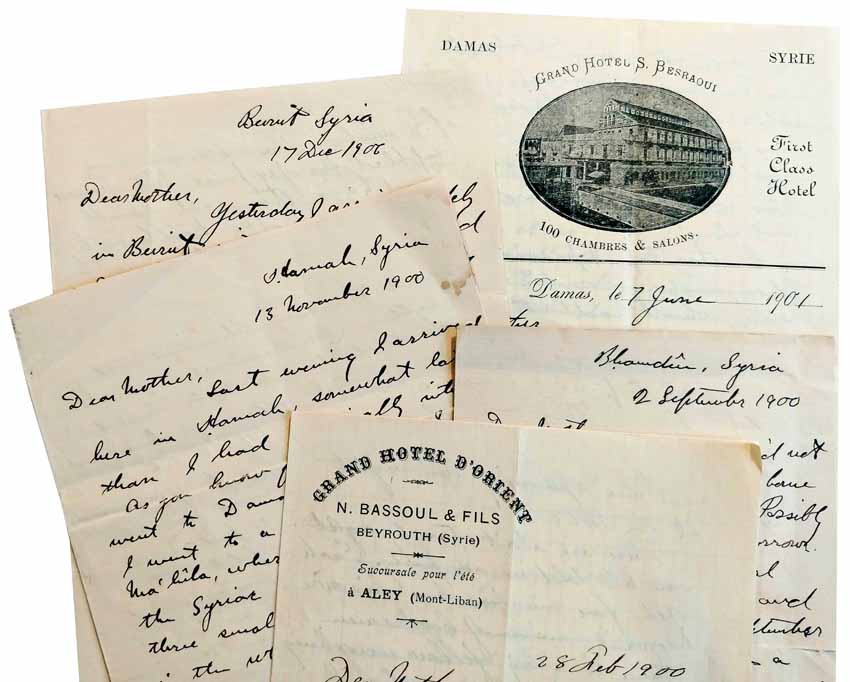
Five Manuscript Letters from the American Archaeological Expedition To Middle East in which he discusses Stone Inscription Discovery which were subsequently Concealed
HUXLEY, Henry Minor Beirut, Damascus, Hama, Bhamdoun: 28 February 1900 - June 1901. Lot of 5 manuscript letters written and signed by Harvard anthropologist Henry Minor Huxley, concerning anthropological work performed for the Howard Crosby Butler Archaeological Expedition to the Middle East, as well as a noteworthy archaeological discovery of an ancient and curious stone inscription, its location guarded with secrecy by the few expedition members having this knowledge. 8vo. double-leafs varying in size. 24 pages combined, each letter signed in the original. Two letters are on hotel stationery. Occasional light creasing, otherwise in very good condition, clean and bright, a fascinating and candid primary source account. Writing to a trusted source, his mother, Huxley's reveals the discovery of an ancient inscription carved into an overturned stone, in a language possibly not yet identified, stating that he took the first photograph of it, and that only a select few expedition members are privy to knowing its location. His commentary on experiences with the local civilians and officials are straightforward and occasionally blunt. Henry Minor Huxley, A.M. accepted the offer to join the American Archaeological Expedition led by American archaeologist Howard Crosby Butler. The first part of the archaeological work took place from mid-October to mid-December 1899, and a second trip was made for continued work from March to June, 1900. In the summer of 1900, he was devoted to acquiring a working knowledge of the vernacular Arabic. Huxley's work, however, involved a broader scope. During this second trip, he was also tasked with the study of physical anthropology, as is apparent in the present correspondence. This work proved so valuable that Huxley, owing to the patronage of New York businessman and archeological enthusiast B.T. Babbitt Hyde, remained for another year to further these anthropological observations, independently. What does not appear to be officially documented in publications, but is highly fascinating, is what Huxley writes in his last letter of the present lot. That is, in June 1901, just prior to returning to America, he alone returned to the site of a stone inscription discovered during the earlier part of the expedition (presumably in 1899), to copy it, photograph it, and turn it back face down so that no others would see it. This would increase the likelihood that he and one other would have a better chance of being the first to decipher it.![Kyuba Shinron. [A New Theory on Raising Horses]](https://rarebookinsider.com/wp-content/uploads/2023/07/31433036517-600x509.jpg)
Kyuba Shinron. [A New Theory on Raising Horses]
Ryuzando Shujin Japan: Suharaya, and others, Kaei 7 (1854). Fascinating and scarce account of a samurai's son whose personal determination led him to rise above the family's financial poverty, to properly care for his horse, build his own stables, and breed additional horses, all by learning the ancient long-forgotten ways of the ancient samurai. 8vo. 1 volume, 78 pages, including 9 full-page illustrations, two of which are hand coloured. Woodblock print. All text is in Japanese. Postscript records the first edition being published in 1806. Traditional karitoji paper binding string-stitched at spine, fukurotoji style ("bound-pocket" with folded leafs bound into spine), and opening from left to right. Natural paper covers, with manuscript title label to front. Together the volumes measure approximately 18 x 25,5 x 1 cm. Negligible creasing to boards and age-toning to upper margins, otherwise in very good and original condition, a pleasing and uncommon work. Based primarily on contemporary descriptions of the financial distress felt by the long-standing prestigious samurai class, such as the present account, it is accepted, without dissent that the ruling samurai class suffered increasing poverty during the Tokugawa (Edo) period. Seifu Murata (1746-1811) wrote: "For years now, the samurai have suffered from poverty and their minds have been occupied by making a living. Buy this, sell that and pawn this to pay for that has become all of their lives. Even for those dedicated to their duties, it was inevitable to debase themselves and to engage in unsavory conduct (i.e., engage in trading)". Even the wives of those who were earning as much as 200 koku busied themselves in trading and in shops. This is the hero's journey, imparted firsthand, of a brilliant young samurai born into poverty but wide-eyed and unrelentingly in pursuit of mastering the skills of a samurai and honouring his destined status in this class of nobility. Young Ryuzando Shujin began by learning the equestrian warrior traditions with a borrowed horse, and was eventually able to convince his father to buy him a horse of his own, despite of the family's economic situation. When the cost of caring for the horse became a burden no longer bearable, and he was told the horse would be sold, he fixated on finding a solution. Immediately, he began conducting extensive research into the ancient methods employed when most samurai were farmers who held the role of warrior in the event of a battle. The solution to combating the costs was breeding and selling. He began the process, while being scrutinized, mocked and judged by others, in particular jeering his rudimentary (cost-effective) hand-made stables. But he did not let any outside opinions pierce his confidence. After repeated trial and error, it was not long that he possessed six horses. Surely too, he had solved the challenges of the household finances. Shujin championed horsemanship as a duty of all samurai. With the belief that all samurai should therefore possess their own horse, in part to best perform archery, spearmanship, and swordsmanship, and owing to the fact that this was an era where some samurai families were poor, he published his methods for others to follow, and ultimately uphold their rights and responsibilities that their title suggests. The volume includes instructions for building horse stables by hand, without incurring high costs. He describes the breeding process, his training methodology, and proper feeding. His own experiences with horses falling to sickness and how he treated them back to health are also shared. Clearly a man with a charitable and honest heart, he concludes by stating that all of this aside, the single most important thing for a healthy and happy horse is "aishin" (affection).- $975
- $975

Manuscript “Private” Account of the Grand Russian Fleet Review Held From 13 to 25 August 1897 in Krasnoye Selo.
Wilfred Seymour - Czar Nicholas II of Russia Manuscript "private" account contemporary to, and describing firsthand, the Grand Russian Fleet Review held from 13 to 25 August 1897 in Krasnoye Selo, by Wilfred Seymour who received a personal invitation to the event, who met and conversed with Czar Nicholas II, and who had fought against Russia in th Crimean War formerly being attached to the Coldstream Guards. 8vo. 7 pages in manuscript on two double leafs, blue paper watermarked "Joynson 1865" measuring approximately 18,5 x 23 cm, dated and initialed by the writer. Together with a manuscript letter also by Wilfred Seymour, written only a few days before, 11 August 1897, while on the steam yacht "Tighnamara" making the voyage to Saint Petersburg for the Presidential celebrations, so mentioned in the text. 8vo. Double leaf ivory paper measuring 13 x 21,5 cm, signed by the writer. Very good condition, a singular primary source "private" account with excellent content. A significant event in Russia's history, of which there is very little documentation, is preserved with remarkable firsthand details, not from a distant observer, but rather from a well-connected Englishman who had a privileged invitation by the Russian Court and who spoke with the Emperor in person during the ceremonies. The event described in these papers marks a most interesting time of Russian relations with European powers, a Franco-Russian Alliance having been established with agreements made from 1891 to 1893 though not officially announced until the conclusion of these ceremonies. At the same time, Anglo-Russian relations were tenuous, the two nations having been rivals for most of the nineteenth century especially in the Crimean War and the Great Game, and just at the time of the Imperial Fleet Review were settling into diplomacy. Within two years of this event, the two would cooperate and join others to protect their interests in China during the Boxer Rebellion. Attending the "Grand Review of Troops" held at Krasnoye Selo, Wilfred Seymour met last Emperor of Russia, Nicholas II, in person, being introduced by the Court Chamberlain. The Czar asked Seymour for his impressions of the review, and also noticed his 1854 Russian War Medal (earned for fighting against Russia in the Crimean War), remarking that at during that time they were enemies, but no longer so. Seymour was subsequently introduced to Alexandra Feodorovna, Empress of Russia as the wife of Nicholas II. He mentions a conversation with the Grand Duke Michael Alexandrovich of Russia (1878-1918), whom also asked him about Crimea. The day before meeting His Imperial Highness, several Grand Dukes and Russian officers, Seymour was present for the laying of the foundation stone for the Neva Bridge.- $1,750
- $1,750

Rare Original Albumen Photograph – Japanese Sericulture – Sorting Cocoons and Feeding Silkworms in 1890s
Photograph Japan, circa 1890s. Original numbered albumen photograph taken by an unidentified Japanese photographer, titled "Feeding Silk Worrms" (sic), showing four females doing the task and one man sorting cocoons in a basket. Photograph measures approximately 26 cm x 20,5 cm. Very faint age-toning, soft crease to one corner, otherwise in very good and original condition, beautifully hand coloured and nicely preserved. Suitable for framing. Silkworms are being fed mulberry leaves, their only food source in their natural habitat, and critical for their survival. They were to be fed as much as possible before they shed their skins. During the month between hatching and spinning, the cocoons needed to be fed every few hours, day and night. As seen in the photograph, silkworms were reared in rectangular mats made of rush or bamboo. The mats were typically stacked on a wooden rack. Producing silk was a lengthy, complex process. The men took responsibility for the mulberry trees, growing the only food silkworms eat, and the women were responsible for the critical task of feeding the leaves to the silkworms. Silkworms do not spin cocoons on demand; timing and temperature have to be handled carefully. If properly coddled with ideal conditions and consistent feeding, the worms eventually spin cocoons for several days, each cocoon made up of a strand of silk several thousand feet long. Over two thousand silkworms are needed to produce one pound of silk.- $275
- $275

Large Colour Albumen Photograph Album Monuments of Ancient Nikko
Kusakabe Kimbei Nikko, 1880's. Album of 18 large-format albumen silver print photographs of Japan with beautiful hand coloring, featuring 12 photographs of the Toshugu Shrine, and the remaining featuring views of the Avenue of Cedars, and the row of Jizo Buddha statues in the Kanmangafuchi Abyss, mostly taken by the renowned Japanese professional photographer Kusakabe Kimbei (1841-1932), and one of which is attributed to Ogawa Kazumasa. Photographs measure approximately 26 x 20 cm, mounted to black art paper affixed to album leafs. Contained in an exquisite and rare photograph album reminiscent of Malta's role in the Great War. Oblong 8vo. album, measuring approximately 35 x 27 x 5 cm, lacquered wood boards illustrated with a naval motif of warships and ensigns of the Entente Powers (Britain, France, Russia) and their supporters (Portugal, Japan, Italy), 9 heavy green and gold cloth-covered cardstock leafs, front and back pastedowns featuring coloured scenes of Malta's natural history on silk. Some wear to boards including fissures to back wooden board, otherwise in Very Good Condition, an exceedingly scarce album containing superb photographs by a renowned nineteenth century photographer.- $750
- $750

Chang-Yu-Sing – Famed Chinese Giant – Original Albumen CDV photograph
Chang-Yu-Sing Rare original CDV photograph of the Chang-Yu-Sing, also known as Chang Woo Gow (1841-1893), popularly dubbed "The Chinese Giant", together with his wife seated beside him. Chang grew to nearly 8 feet in height, married a beautiful "normal" named King Foo (her name literally means "the fair lily"). Photographed and published by The London Stereoscopic & Photographic Company whose studio was situated on Regent Street, between 1865 and 1867. Chang-Yu-Sing was a famous circus and sideshow performer, and was prolific in the business. He performed with Barnum, Bailey, and Hutchinson. Standing at 7 feet and 8.75 inches (235.5 cm) tall, in some performances, he appeared with "Chung Mow, The Chinese dwarf," making a most dramatic contrast and most engaging performance. Early biographical accounts state that he was born in the city of Fychow in Au-Hwy province [Huizhou in Anhui], in Eastern China, a region in the basins of the Yangtse and Huai rivers. He was a man of exceptional intelligence, speaking at least 10 languages. He was well-travelled, owing to the nature of his work. In 1865, he was persuaded to tour London, and headed the call, departing from Shanghai with Lady Chang, Chung Mow, his interpreter, two other Chinese individuals Alook and A'Yang, and an agent James Marquis Chisholm. In London he held levées at the Egyptian Hall and was invited to Malborough House to visit the Duke of Cambridge.For several years he toured England. He was an attraction at the Paris Exposition of 1867, visited Ireland, then Scotland where he celebrated New Year's Eve 1869 in Aberdeen. His agent at this time, since 1869 or earlier, was Edward Parlett.- $375
- $375

12 Masterpieces of Korean Arts with the Seal of the President of Korea.
Anon. A special copy, bearing the South Korean Presidential Seal, quite conceivably a unique one-off presentation copy from the Korean Government, of the photogravure portfolio, showcasing a select few of the exquisite Korean art works, which were jointly selected by a Korean-American committee and displayed at the National Gallery of Art in Washington, D.C. exhibition "Masterpieces of Korean Arts" held from 15 December 1957 to 12 January 1958. Folio. Complete, with 12 full colour photogravures, each bordered with loosely placed captioned leaf, and contained in its own folding cardstock covers bearing the portfolio title to front and a detailed historical and physical description to interior. Folders open from left to right, suggesting that this work was printed in Korea. Text is in both Korean and English. Publisher's original cloth teal and gold patterned portfolio covers, with two intact bone clasps for secure closure, and gilt presidential seal to front. Photogravure leafs measure approximately 42,5 x 34 cm. Portfolio measures approximately 43 x 34,5 x 3,5 cm Mild age-toning and wear to boards with one cosmetic tear to cloth to interior of one flap, otherwise in very good and original condition, a most unusual variant of this beautiful work, and most likely a Presentation copy from the South Korean Government. The present item is quite rare in any state, but especially this one as it shows a gilt phoenix and flower (Rose of Sharon) emblem found on the presidential seal of South Korea. It is most likely a Presentation Copy from the Korean Government to America, as a memorial to their collaboration of hosting a superb exhibition of historic Korean Art. OCLC shows a few 'standard' editions in libraries. The status and authority of the President of South Korea, officially the Republic of Korea, is represented by a symbolic phoenix emblem. The virtues represented by the mythological bird are parallel to the values a king had to pursue in governing the people, and the design of phoenix was attached on the ceiling of the throne hall of Gyeongbokgung palace, which was the main palace during much of the Joseon Kingdom (1392-1910). The design of the phoenix is still used today as the emblem that represents the office of the President of Korea. The exhibition "Masterpieces of Korean Art" was held at the National Gallery of Art in Washington, D.C., from 15 December 1957 to 12 January 1958. A joint committee of Koreans and Americans selected 187 objects, with the aim of presenting a cross section of Korean art from 200 B.C. to about 1900.- $375
- $375
![Honzo Zufu [Illustrated Manual of Medicinal Plants / Iconographia Plantarum]](https://rarebookinsider.com/wp-content/uploads/2023/07/31376698237.jpg)
Honzo Zufu [Illustrated Manual of Medicinal Plants / Iconographia Plantarum]
Iwasaki Tsunemasa (Kan-en) A most pleasing and highly illustrative Japanese monograph on mushrooms, being a copy of the work on medicinal mushrooms, from the multi-volume compendium of Iwasaki Tsunemasa titled Honzo Zufu. 8vo. 54 pages, offset colour-printed facsimile. Traditional karitoji paper binding string-stitched at spine, fukurotoji style ("bound-pocket" with folded leafs bound into spine), and opening from left to right. Ivory paper covers, title label, official red ink stamp to the first text leaf. All text is in Japanese. Volume measures approximately 17,5 x 26 cm. Very good condition, a visually striking historic work. Only six original sets of his work exist in Japan. The Royal Botanic Gardens, Kew, also possesses a complete set of the original manuscript volumes with hand-coloured woodblock print illustrations; else this monumental work is exceedingly scarce. Honzo Zufu or "Illustrated Manual of Medicinal Plants" is the work of Tsunemasa Iwasaki (1786-1842), a Japanese botanist, zoologist and entomologist who compiled and published the valuable compendium in 93 volumes between 1830 and 1844. Honzo Zufu comprises illustrations and descriptions of some 2,920 plants, chiefly of Japanese origin. A classic work of botanical classification, begun in woodcut, then continued in manuscript form during the mid-19th century, it was finally edited by Shirai and published in final form, printed by colour woodblock with descriptions of species in Japanese, and accompanied by a Japanese-Latin index, in 1920-22. In 1828 the first volumes of Honzo Zufu were printed, with uncolored woodcut prints. Beginning in 1829, he issued manuscript volumes of a vastly expanded work under the same title, beautifully illustrated by watercolour paintings. Tsunemasa Iwasaki continued to work diligently, printing and distributing new volumes at the rate of about four volumes per year until the work was finished. A complete set is said to have been presented and dedicated to the Shogun in 1844, signaling its completion on a most honourable manner. Iwasaki was better known as Kan-en, his sobriquet which translates literally to "irrigation of a garden for plants". He was a samurai in the service of the Tokugawa Shogunate, a born naturalist, and had access to about 150 illustrated volumes of Japanese botanical books. In 1826 at Edo, he had also become acquainted with the German physician and botanist Philipp Franz Balthasar von Siebold (1796-1866) who achieved prominence by his studies of Japanese flora and fauna and the introduction of Western medicine in Japan. He was the father of the first female Japanese doctor educated in Western medicine, Kusumoto Ine.- $750
- $750

Kamishibai Propaganda Play, Titled Uesugi Yozan, Containing Colour Illustration of Samurai Warriors Working in the Fields Aid in Food Production for the Nation at War.
Anon Kamishibai propaganda play / Japanese picture show (kamishibai) illustrating Samurai warriors plying away in the fields aid in food production for the nation at war. Folio. The complete work, comprising 20 offset full-colour printed illustrative cards which together form a story to educate or indoctrinate the viewer with nationalist concepts during the Second World War, each with printed story text to verso, one of the cards being the title and publishing information. Text is in Japanese. Contained in publisher's original paper portfolio covers, with title label to front. Story cards measure approximately 38 x 26 cm. Portfolio covers measure approximately 39 x 27 x 1 cm. Some age-toning and wear to portfolio, otherwise in very good and original condition, cards retaining vivid impression, a fascinating and scarce Second World War propaganda presentation. Japanese wartime propaganda was distributed through films, magazines and newspapers, radio, books, cartoons and the education system. Publications such as the present illustrative stories, promoted the ideal citizen's nationalistic point of view, indoctrinating civilians to work collectively and in support of their government's actions, even when creating some form of imposition on the citizen himself. Kamishibai are Japanese paper plays that gained popularity among children in the 1930s and were subsequently used as a medium for propaganda during World War II. Also referred to as a "Picture Card Show," they were made for influencing youth with their engaging storylines and vivid imagery. In 1940, elementary schools were renamed "Citizen's Schools." Textbooks became vivid, engaging, and contained militaristic picture-books. During the course of World War II, the Japanese government attempted to indoctrinate Japanese children through education and propaganda. Both methods nationalized youth and encouraged them to support the war effort. Science curriculum, for example education taught children about agriculture so they could better assist in food production for the nation. Youth were expected to volunteer in factories and farms to replace the conscripted labor force. Additionally, "kokutai," meaning the uniqueness of the Japanese people in having a leader with spiritual origins, was officially promulgated by the government, including a text book distributed by the Ministry of Education. The purpose of this instruction was to ensure that every child regarded himself first of all as a Japanese and was grateful for the "family polity" structure of government, with its apex in the emperor. Indeed, little effort was made during the course of the war to explain to the Japanese people what it was fought for; instead, it was presented as a chance to rally about the emperor. This is a story of Samurai warriors working in the fields with ordinary people in order to help grow food, a clever example using the elite class that all look up to, in order to encourage citizens to contribute to Japan's efforts in World War II. It is cleverly named after the famous and revered Uesugi Yozan, who at the young age of 17 became daimyo of the economically failing Yonezawa domain, and through hard work and sacrifice, led his people and feudal land back to prosperity. Uesugi Yozan (1751-1822), the daimyo (feudal baron) who restored the fortunes of the impoverished Yonezawa domain, is famously known as one of Japan's most virtuous lords. Perhaps the most famous words left by Yozan are, "To achieve, one must act. To not act is to not achieve; this is true in all things. The inability to achieve is the result of inaction." Indeed, Yozan is a fitting an influential figure to support this propaganda and motivate citizens to contribute their efforts to winning the war.- $1,750
- $1,750
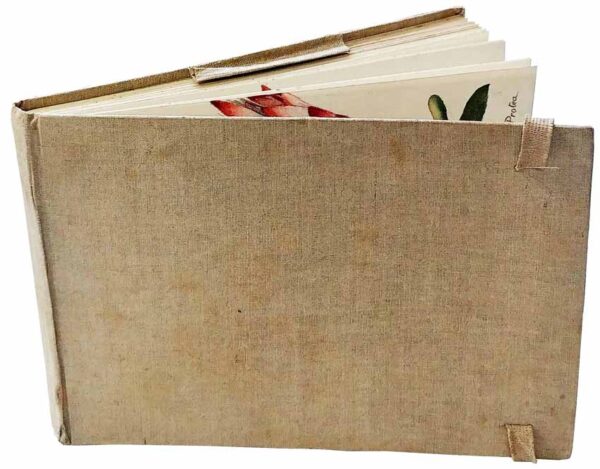
Album of Watercolour Albums: South Africa Botanicals.
Anon Album of watercolours devoted to flowering plants native to South Africa. Contains 30 images hand drawn and painted recto only one per leaf, most named in manuscript by the artist. A presentation copy inscribed to front pastedown, "E. Lawdon. From J. Bincker Dec. 1906". Oblong 8vo. sketch book made by Winsor & Newton whose label is affixed to front pastedown, with Whatman's drawing paper, taupe cloth boards, pencil sleeve (pencil not present), and a stretch band for secure closure. Volume measures approximately 19 x 13 cm. Minor age-toning to boards, small ink marks to verso, otherwise in very good condition, internally clean and bright, A pleasing work with lovely renderings of South African flora. Some of the flora painted in the present album include: Protea; Erica; Morea (commonly known as the Cape tulip); Aloe Davyama; Erythina Caffra (the African Coral tree); Ornithogalum; Gladiolous; Striilitzia; Vellozia retinerius; Striga elegans; Watsonia; Crassula; Hypoxis; Salvia africana; Gomphocarpus. The artist may be Johanna Jacoba Brincker (1842-1923, née KNAB) of Stellenbosch, South Africa. Johanna Jacoba Knab was born in South Africa, on 12 June 1842 in Stellenbosch. Little is known about Johanna, though she lived in South Africa and Southwest Africa [now Namibia] for her whole life, and she was a missionary to the Herero people, having a complete understanding of their language and customs. We get a fuller picture of her adult life through her husband, putting her in the circles of notable German Rhenish missionaries. On 10 February 1864 in Stellenbosch she married German missionary Peter Heinrich Brinckner, born 9 May 1836 in Isselhorst, Westfalen. Brinckner had arrived in South Africa in 1863. After completing his theological training, Brincker was ordained in November 1862 and seconded to German South West Africa on 5 November 1862, with the task of proselytizing the Herero and Nama, who were at odds with one another. After an 83-day journey, he landed in Cape Town at the beginning of February 1863. In Stellenbosch, about 50 kilometers east of Cape Town, he was welcomed by missionary brothers. There he met his future wife Johanna Rath and became engaged to her. Missionary Johann Rath, who had worked with the Herero for 15 years, introduced Brincker to the Herero language. By early 1864 Peter had returned to Stellenbosch, where he married Johanna. Together, on 20 February 1864, they took over the work in the mission station of Otjikango, called Klein-Barmen, which had been founded twenty years earlier. Because of fighting between Herero and Nama, the couple had to flee to Otjimbingwe seven times over the next year and a half. In September 1865 the station in Otjikango was destroyed by the Nama and had to be painstakingly rebuilt.- $975
- $975
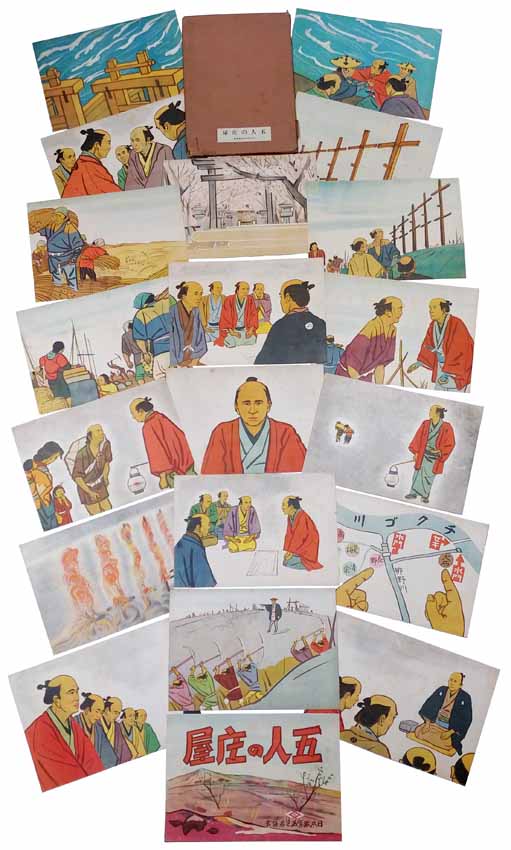
Kamishibai Propaganda Play, Titled Gonin no Shoya, Containing Colour Illustrations to Depict Five Innovative Heroic Headmen.
Anon Creator: Hiroshi Hirabayashi. Kamishibai propaganda play / Japanese picture show (kamishibai) illustrating the benefits and immense moral obligation of collaborating with one other for survival. Folio. The complete work, comprising 20 offset full-colour printed illustrative cards which together form a story to educate or indoctrinate the viewer with nationalist concepts during the Second World War, each with printed story text to verso, one of the cards being the title and publishing information. Text is in Japanese. Contained in publisher's original paper portfolio covers, with title label to front. Story cards measure approximately 38 x 26 cm. Portfolio covers measure approximately 39 x 27 x 1 cm. Some age-toning and wear to portfolio, otherwise in very good and original condition, cards retaining vivid impression, a fascinating and scarce Second World War propaganda presentation. Japanese wartime propaganda was distributed through films, magazines and newspapers, radio, books, cartoons and the education system. Publications such as the present illustrative stories, promoted the ideal citizen's nationalistic point of view, indoctrinating civilians to work collectively and in support of their government's actions, even when creating some form of imposition on the citizen himself. Kamishibai are Japanese paper plays that gained popularity among children in the 1930s and were subsequently used as a medium for propaganda during World War II. Also referred to as a "Picture Card Show," they were made for influencing youth with their engaging storylines and vivid imagery. In 1940, elementary schools were renamed "Citizen's Schools." Textbooks became vivid, engaging, and contained militaristic picture-books. During the course of World War II, the Japanese government attempted to indoctrinate Japanese children through education and propaganda. Both methods nationalized youth and encouraged them to support the war effort. Science curriculum, for example education taught children about agriculture so they could better assist in food production for the nation. Youth were expected to volunteer in factories and farms to replace the conscripted labor force. Additionally, "kokutai," meaning the uniqueness of the Japanese people in having a leader with spiritual origins, was officially promulgated by the government, including a text book distributed by the Ministry of Education. The purpose of this instruction was to ensure that every child regarded himself first of all as a Japanese and was grateful for the "family polity" structure of government, with its apex in the emperor. Indeed, little effort was made during the course of the war to explain to the Japanese people what it was fought for; instead, it was presented as a chance to rally about the emperor. This is a dramatic story of collaboration and innovation, its ultimate message being that these virtues are necessary for survival of a society and the individual. Sustenance being the key to survival, the story unfolds as follows. A village in Western Japan suffering a long arid season which led to drought, was unable to support vegetation and was seeing abandonment as many farmers left the region. Evidently this was a large village, having five shoya (village headman), and the latter devised an irrigation plan to restore its agriculture and ultimately preserve the village. In order to instill the urgency of success with the undertaking, the local bugyo (governor) approved the project under the alarming condition that if the project failed, the five headmen who also owned estates in the region, would be burnt alive at the stake. He had five hanging platforms erected in preparation of failure, and also to motivate them to accomplish the task lest they meet a gruesome public fate. Villagers supported the idea and all hands worked diligently to ensure its success. Indeed, working together with a common goal was the key. The water flowed abundantly. The village was saved, and so were the li- $1,750
- $1,750

Kamishibai Propaganda Play, Titled Ninomiya Kinjiro, Containing Colour Illustration Intended to Portray the Importance of Taxation, Specifically Relating to the All-Important Commodity, Rice.
Anon Kamishibai propaganda plays / Japanese picture show (kamishibai) illustrating the importance of taxation, specifically relating to the all-important commodity: rice. Folio. The complete work, comprising 20 offset full-colour printed illustrative cards which together form a story to educate or indoctrinate the viewer with nationalist concepts during the Second World War, each with printed story text to verso, one of the cards being the title and publishing information. Text is in Japanese. Contained in publisher's original paper portfolio covers, with title label to front. Story cards measure approximately 38 x 26 cm. Portfolio covers measure approximately 39 x 27 x 1 cm. Some age-toning and wear to portfolio, otherwise in very good and original condition, cards retaining vivid impression, a fascinating Second World War propaganda presentation. Japanese wartime propaganda was distributed through films, magazines and newspapers, radio, books, cartoons and the education system. Publications such as the present illustrative stories, promoted the ideal citizen's nationalistic point of view, indoctrinating civilians to work collectively and in support of their government's actions, even when creating some form of imposition on the citizen himself. Kamishibai are Japanese paper plays that gained popularity among children in the 1930s and were subsequently used as a medium for propaganda during World War II. Also referred to as a "Picture Card Show," they were made for influencing youth with their engaging storylines and vivid imagery. In 1940, elementary schools were renamed "Citizen's Schools." Textbooks became vivid, engaging, and contained militaristic picture-books. During the course of World War II, the Japanese government attempted to indoctrinate Japanese children through education and propaganda. Both methods nationalized youth and encouraged them to support the war effort. Science curriculum, for example education taught children about agriculture so they could better assist in food production for the nation. Youth were expected to volunteer in factories and farms to replace the conscripted labor force. Additionally, "kokutai," meaning the uniqueness of the Japanese people in having a leader with spiritual origins, was officially promulgated by the government, including a text book distributed by the Ministry of Education. The purpose of this instruction was to ensure that every child regarded himself first of all as a Japanese and was grateful for the "family polity" structure of government, with its apex in the emperor. Indeed, little effort was made during the course of the war to explain to the Japanese people what it was fought for; instead, it was presented as a chance to rally about the emperor. By using the example of the esteemed agrarian reformer and economic savant Ninomiya Kinjiro who was born into peasantry, lost his family and home in a disaster, and overcame all odds to become a notable leader and economic reformer, this story promotes the importance of government taxation, even on basic needs such as rice. Ninomiya Kinjiro (1787-1856) was an important agrarian reformer and economic thinker of the late Edo period. His legendary diligence and studiousness as a child made him a natural exemplar for Japanese schoolchildren. At one time, most every elementary school in Japan displayed a statue depicting Ninomiya as a youth with a bundle of firewood on his back and an open book in his hand.- $1,750
- $1,750

Poster Calendar from a Chinese Artist Promoting the Qidong Tobacco Company.
Ni Gengye Poster calendar titled "Girl at Airfield" and designed by artist Ni Gengye, for the Qidong Tobacco Company, to promote happiness in connection with their smoking products. From the collection of Agnes Tabah. Calendar measures approximately 103 x 38 cm. Ni Gengye is a Chinese artist whose work is highly sought after, and which fetches a premium when available on any market. He produced a notable number of works, many of them being calendar posters. He created advertisements for other tobacco companies including Hatamen Tobacco and the British American Tobacco (BAT). His date and place of birth are unknown, though some estimate his life span to be from approximately 1900-1965. Calendar posters were a particular genre of commercial imagery of the period. Typically, they were produced by tobacco, textile, soap, or perfume companies and were distributed across a wide geographical range. Almost invariably, they depict female figures in various guises, which were a key part of their appeal. Formally, the female figures are generally portrayed in an illusionistic manner, though chiaroscuro or shading is generally subdued. There is usually a frame, outside of which an image of the product and other necessary information are displayed. This 'calendar-poster' style had strong connotations of commercialism and was consciously avoided by designers of literary book and magazine covers. This stylistic differentiation probably served to mark literary works as a different type of commercial product. The format of the present poster-calendar was designed by Zhang Guangyu around 1931. It was mostly frequently tall and narrow, into which he introduced a large plaque for the calendar in the lower third of the space. This plaque itself was framed with ornamental designs and contrasted against a richly decorated background of various motifs. The tobacco vendor's cigarette packages were arranged on each side of, and sometimes below, the central plaque. This formula was frequently utilized, and spin-offs continued at BAT throughout the 1930s. It is thought that Ni Gengye's "Woman at an Airfield" is among the last uses of Zhang's formatting design. It is dated 1938 according to the reign characters Kangde, indicating that the poster was probably destined for advertisement in Manchuria, where the Japanese had set up the puppet state of Manchuko. The woman waves as if greeting an unseen person, having alighted from the airplane in the background, as she moves across the field toward the terminal. An alternate interpretation is also possible: the young woman might be departing, making her way across the tarmac, but turns to wave farewell to a friend, just prior to boarding the aircraft. If this is the case, Ni's picture is an ironic, unwitting, and poignant farewell to the era of advertisement calendars, for by 1938, the Japanese, entrenched in Shanghai, succeeded in pretty much cutting it off from the trade world and from the rest of China.- $375
- $375
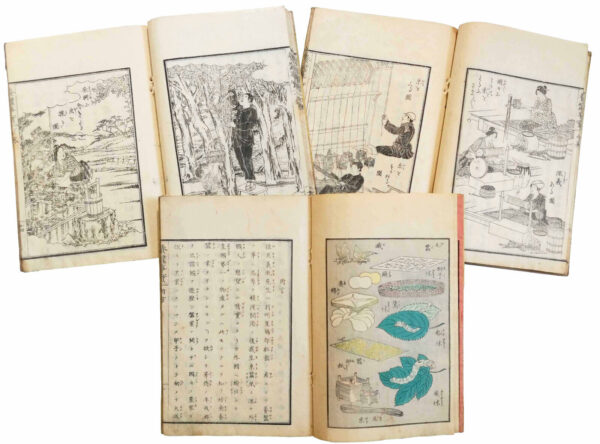
San Jijitsu. Japanese Coloured Woodblock Prints on Sericulture (Making of Silk).
Sakai Yoshitane A rare nineteenth century Japanese tutorial on sericulture (the making of silk), including details on the silk worms from which the fine thread is harvested, produced in woodblock print. 8vo. 3 volumes, 209 pages combined, with publisher's details to red frontis leaf. The complete text, including 31 full page wood printed illustrations - the first three being beautifully hand coloured. Traditional karitoji binding ("semi-bound" meaning title page and contents without a book cover) string-stitched at spine, fukurotoji style ("bound-pocket" with folded leafs bound into spine), and opening from left to right. Yellow paper covers, titled in manuscript ink to verso. Each volume with a red ink stamp to the first text leaf. All text is in Japanese. Each volume measures approximately 15 x 22 cm. Housed together in purpose-made three-panel folding portfolio, blue cloth boards with working bone clasps, measuring approximately 16,5 x 23 x 3,5 cm. Ink blemishes to two of the illustrations, quite likely a printing mishap, minor age-toning primarily to boards, otherwise very good and original condition, a pleasing historic work dealing with silk production in Japan. Beginning with three lovely hand-coloured woodcut illustrations, the first volume describes the coveted miniscule Bombyx mori that creates the delicate strands that are used to produce the world's finest fabric. It goes on to explain the process, how to lay the eggs on a sheet of paper, the importance of harvesting mulberry leaves to feed the larvae, transferring grown silkworms to other bamboo mats to feed them, and the multiple tools needed for the job at hand. Fieldwork is the focus of the second and largest volume, which demonstrates the arduous task of planting and maintaining a mulberry plantation, which will ultimately determine the health of the silkworms and one's profitability. In the third volume, we see men gathering twigs and women loosely weaving these into safe-havens for the silkworms to settle comfortable. The cocoons are placed on round trays, and eventually the silkworm moth fly away after hatching. Various stages of preparing the thread are shown, for example stretching the silk floss hand-spinning the thread from cocoons sitting in a pan of boiling water. A merchandising scene concludes the illustrations.- $1,250
- $1,250
![Banpaku Shimoda nyuko kikigaki. [Oral Accounts on Foreign Ships which Entered Shimoda Port.]](https://rarebookinsider.com/wp-content/uploads/2023/07/31351517008-600x511.jpg)
Banpaku Shimoda nyuko kikigaki. [Oral Accounts on Foreign Ships which Entered Shimoda Port.]
Anon. Invaluable manuscript chronology of the earliest ships entering the port of Shimoda after the implementation of the Japanese-American treaty which opened up foreign trade with the previously isolationist nation, covering two years from February 1854 to February 1856, presented in the meticulous hand of a contemporary observer who compiled firsthand information as well as his own, together with a manuscript drawing of a Dutch sea captain in naval attire, made by Kitajima Toen. Manuscript: 8vo. 30 pages plus titled cover, string-tied at center of spine with rolled up paper, opening from left to right, measuring approximately 17 x 24 cm. Text is in Japanese, with occasional annotations in red ink. Drawing: Single leaf measuring approximately 24 x 33 cm, titled and signed in manuscript, with red ink stamp. Some creasing and indication of burrowing, otherwise in very good and original condition, clean and bright internally, an invaluable log of the earliest trade activity from the onset of the Convention of Kanagawa. With precise details, the writer keeps a record of vessels from America, Russia and France, arriving at Edo Bay, beginning with the return of Commodore Perry in February 1854 for the signing of what would be the Kanagawa Treaty, and continuing for two full years, featuring descriptions of the ships including dimensions and armament, repairs and supplies procured, captains' names and crew sizes, and their activities in Shimoda. This document is not only an invaluable historical log of the first and most significant foreign vessels to interact with Japan during the formative years of the Unequal Treaties, it may have been used in the Japanese study of foreign ships for their own benefit. Immediately after bowing to the demands of the powerful Western ships and their commanders, an active assimilation of Western technological advances in warships ensued in the Japanese Navy. In 1855 Japan acquired its first steam driven warship, and in 1857 its first screw driven warship. Japanese Naval students were sent abroad to naval schools in England, France, the Netherlands, and the like. By the end of the Tokugawa Shogunate in 1867, its navy would possess eight western-style steam warships. The first vessels mentioned in the manuscript are from Perry's daunting and expanded 'Black Ships' fleet, including the Mississippi which had been one of the original four, as well the Vandalia, the Southampton, the Powhatan, and the Supply, the latter of which joined the squadron after the actual landing on 8 March. The Russian vessels being described in 1854, include the Russian Imperial Navy flagship frigate 'Diana' commanded by Vice-Admiral Euphimy Vasil'evich Putiatin, and possibly his former flagship frigate 'Pallada' which had been performing survey missions around the Japanese coast since 1853 and whose crew was transferred to Diana upon her arrival. The crew members of the Diana are listed by name, including her Imperial Navy officers, a cook, a waiter, and an interpreter. The earliest French vessel to arrive after Commodore Perry's successful treaty implementation, was a cruiser that arrived in Shimoda in February 1855, being 'Le Lion' which also landed at the Ryukyu Islands with the French missionaries from the 'Missions Étrangères de Paris', Girard, Furet and Mermet, hoping to discuss their interests in evangilizing. Catholicism was strictly forbidden in Japan. They also landed at Naha, the main port of Okinawa, on 26 February. The cruiser was denied any official communication as a formal agreement did not exist between France and Japan. On this voyage, Father Louis Théodore Furet, an apostolic missionary, carried out instrumental observations at Nafa [Naha, Okinawa] on the Ryûkyû Islands. A set of the meteorological manuscripts by Father Furet was given to Jean Barthe, the physician onboard the French frigate 'La Sibylle', who forwarded them to the 'Académie des Sciences' in Paris and to the 'Société Météorologique de France'. Mete- $1,750
- $1,750
![Zokui Yosan Shinron. [Additional New Theories on Sericulture]](https://rarebookinsider.com/wp-content/uploads/2023/07/31351517007-600x515.jpg)
Zokui Yosan Shinron. [Additional New Theories on Sericulture]
Anon Historically significant and exceedingly scarce nineteenth century Japanese treatise on sericulture (the making of silk), by the man who remembered as "the father of modern sericulture and silkworm rearing methods", describing and illustrating his then revolutionary methods for better nurturing of the silk worms from which the fine thread is harvested, and ultimately producing higher quality silk, the inventions having become the standard for the industry and still employed today, produced in woodblock print. 8vo. 3 volumes, 278 pages combined, plus publisher's details to yellow frontis leaf in first volume. The complete text, illustrated with 10 pages of wood printed illustrations, two of which are fully hand coloured, and two being partially hand coloured. Traditional karitoji binding ("semi-bound" meaning title page and contents without a book cover) string-stitched at spine, fukurotoji style ("bound-pocket" with folded leafs bound into spine), and opening from left to right. Black paper covers, with title label to front, the first volume with a red ink stamp to publisher's detail leaf. All text is in Japanese. Together the volumes measure approximately 14,5 x 22 x 3 cm. Minor wear to boards, otherwise very good and original condition, internally bright, a pleasing historic work dealing with silk production in Japan. Tajima Yahei (1822-1898) was an influential silk farmer in the early Meiji period, whose legacy is that of a tremendously prosperous impact on the sericulture industry of Japan, with his development of a ventilation theory and method which proved to be highly successful and subsequently laid the foundations for modern sericultural production, and the most efficient design of a sericulture space. He had a small laboratory where he researched silkworm hybridization and silkworm diseases with the aid of a microscope, which was unusual in Japan at the time. Yahei's experiments in creating an ideal sericulture space led to his invention of a new sericulture theory and technique, the seiryo-iku. He concluded that sericulture is best carried out in a space with efficient cross ventilation, which includes a roof system and openings on four walls. He perfected these procedures at his own home, the farmhouse known as 'omoya' built in 1863, referred to today as the Tajima Yahei Sericulture Farm (Tajima Yahei kyu-taku), which is located in the Sakaishima neighborhood of the city of Isesaki, in the southern part of Gunma Prefecture. Silkworm growers travelled from far and wide to observe and learn the techniques and processes developed and implemented on this revolutionary farm. Yahei was also involved in exporting silkworm eggs and earned large profits from it. Yahei's techniques later became a foundation for the secchu-iku theorized by Takayama Chogoro, founder of Takayama-sha Sericulture School, which acted as a training centre and formal education institution for sericulture. Yahei also became one of the leading figures who developed the village of Shimamura through his achievement in sericulture. Born in 1822 as Tajima Kuniyasu and Yahei (the second), throughout his childhood, he travelled to advanced sericulture areas with his father in order to gain skills and experience in silkworm breeding, production and sales. Yahei's silkworm farm is one of the earliest examples of architecture specifically designed to improve sericulture.- $1,750
- $1,750
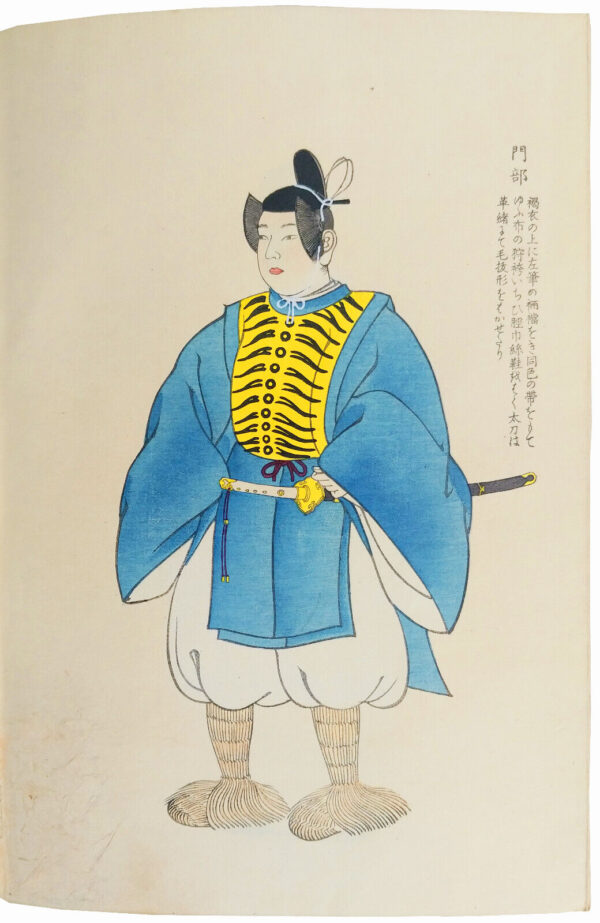
Reifuku Chakuyo Zu.
Imaizumi Sadasuke An outstanding illustrative work to record the details of the ceremonial dress worn in the Japanese Court, produced by Imaizumi Sadasuke, a scholar of the Kokugaku movement which emphasized Japanese classical studies who evidently researched the works of the eighteenth century noble Heizo Sadatake Ise. Woodblock print. The complete work. 8vo. 1 volume, opening from left to right, 16 pages, with 14 woodcut images, all of which are beautifully hand-painted in full colour and captioned in margins. Text is in Japanese. Title noted in manuscript to bottom fore-edge. In publisher's original yellow striped paper boards, with title slip to front. Traditional karitoji binding ("semi-bound" meaning title page and contents without a book cover) string-stitched at spine, fukurotoji style ("bound-pocket" with folded leafs bound into spine), and opening from left to right. Volume measures approximately 18 x 26 x 0,5 cm. Indication of additional small label removed from covers, otherwise in very good and original condition, a stellar work with vivid, meticulously coloured, woodcut illustration, internally crisp and clean. The official dress worn by court officials of early Imperial Japan, painted with meticulous detail to bring depth and vibrant colour. Court dress was unique to those possessing court ranks and those holding official positions. Fascinating accoutrements shown in the present volume include straw boots (waragutsu), ogi (folding fan), the kanmuri (tall black-lacquered silk gauze hat) worn by Shinto clergy, aristocrats and courtiers, remarkable gilded headdresses, high officers' kimonos made of the highest quality, exquisitely decorated fabric and military arms including the katana (curved sword), the tachi (traditional sword). The Bukan sokutai (ketteki no sokutai) sugata is the formal court wear (sokutai) of the military official (which is the meaning of 'bukan'). It was worn only by military officials of the fourth court rank and below. Men of the first through third rank wore the bunkan sokutai even if they held military appointments. The principal garment is the ketteki no ho. It featured, first, the kanmuri has a ken'ei (a wrapped tail) and oikake (lacquered horsehair "blinders" that sit on the cords of the kanmuri). The shoes are lacquered leather kanokutsu (a riding boot). Being a military outfit, a sword (hosotachi) is worn off the hirao, while a bow (yumi) is held in the hands. The quiver, either a hira yanagui (square quiver) or tsubo yanagui (a round quiver), holds arrows with two large hawk feather fletchings. For a hira yanagui, one has 15 or 22 arrows, depending on the school (Takakura Ryu or Yamashina Ryu), though only 7 arrows for a more restrictive tsubo yanagui. Although the hanpi may sometimes be dispensed with when wearing bunkan sokutai, it can never be left off when wearing bukan sokutai, since it can always be seen through the open sides. The Kachie sugata is the uniform of the imperial guards when on duty. The outfit is so named due to the kachie being the principal garment. It may look, superficially, like the bukan sokutai, but there are crucial differences. Although the kanmuri sports oikake, the tail is a thin one called a hosoei. Furthermore, the shitagasane and accompanying kyo, as well as the akomé are left off. Rather than the formal uenohakama, this outfit uses the more practical onohakama. The shoes are either cloth/hemp shoes, such as the makai, or straw shoes or boots (waragutsu). The sword worn is often a kenukigata tachi, or else a tachi in black mounts, and they are also likely to have a bow, quiver, and arrows.- $975
- $975

Manuscript Watercolour Map Illustrating the Village of Ashinazawa Tamayamababa and Its Environs, Depicting Japanese Samurai Horse Breeding Grounds
Anon. Large manuscript watercoloured map to illustrate the village of Ashinazawa Tamayamababa and its environs (in present-day Morioka, Iwate Prefecture), showing lands used by samurai of the ruling Nanbu Clan for raising and breeding horses, also highlighting three mountains in relief by way of tipped-in folding cutouts. Place names and text is in Japanese. Signed in manuscript by a Samurai named Sakura Baba, as well as three other notable officials. Map measures approximately 135 x 82 cm. Some creasing, otherwise in very good condition, a very unique manuscript painted map from the feudal Morioka Domain. The village shown is Ashinazawa Tamayamababa, situated within 30 km from Morioka, which was then the Morioka Domain (Morioka-han), a tozama feudal domain of Edo period, under the rule of the Nanbu Clan (Nanbu-shi) of samurai whose territory spanned most of northeastern Honshu in the Tohoku region. [Today, Morioka (Morioka-shi) is the capital city of Iwate Prefecture located in the Tohoku region of northern Japan. Ashinazawa is considered part of the Morioka district.] Ashinazawa Tamayamababa is also near, only 90 km, from Kakunodate (in present-day Akita Prefecture), also a former castle town and samurai stronghold. While Kakunodate Castle no longer remains, the town is famous for its samurai tradition and its hundreds of weeping cherry trees (shidarezakura). Apart from the loss of its castle, Kakunodate remains remarkably unchanged since its founding in 1620. The town was built with two distinct areas, the samurai district and the merchant district. Once home to 80 families, the samurai district still has some of the best examples of samurai architecture in all of Japan. Among the hills and near the village, some rather expansive horse-breeding fields are drawn on the map, presumably belonging to or at least managed by the Nanbu-shi samurai who signed the document. The horses would have been used by samurai warriors for military equestrianism, including bajutsu (a distinct form of martial art), for yabusame (mounted archery), and other practices of skilled battle on horse-back. Three mountains illustrated two-dimentionally, are all stratovolcanos forming part of the Ou Mountain range in the Tohoku region of northern Honshu. They appear to be illustrating Mount Iwate - the active volcano situated only 22 km from Ashinazawa, Mount Hachimantai - the highest peak in the Ou Mountains and only 46 km from Ashinazawa, and the active stratovolcano Akita-Komagatake located some 70 km from Ashinazawa. In red paint, several roadways are delineated, one of them reaching and following the summit line of one of the mountains. At the head of one of these roads, is a drawing of a cherry blossom trees, and an inscription which likely reads 'sakura', the term for of a group of cherry blossom trees, collectively. The flow of the Kakkonda and Shizukuishi rivers into the Kitakami is traced from the hills. In the distance, on the opposite side of the mountain ranges, a larger river is drawn, depicting the wider Tama River, which would eventually lead to Lake Tazawa. The Akita-Komagatake region is exceptionally lush, with several hundred species of alpine flora and would surely be an excellent place for horses to graze. Mount Hachimantai is especially characterized with hot springs, possibly being used as a source of warm water for cleaning or healing. In general, the vast region would be superb as a horse breeding ground. Horsemanship was an important duty and respected skill of the samurai. There were two classes of Samurai, and only upper-class samurai were allowed horses, although the lower class samurai who could find a way to possess their own horse, did so, with the belief that every samurai should have the honour and the benefit. Being on horse-back aided in part to best perform archery, spearmanship, and swordsmanship in battle. Horse-mounted samurai often fought by charging their horses at their opponent, in some cases causing a collision that- $2,750
- $2,750
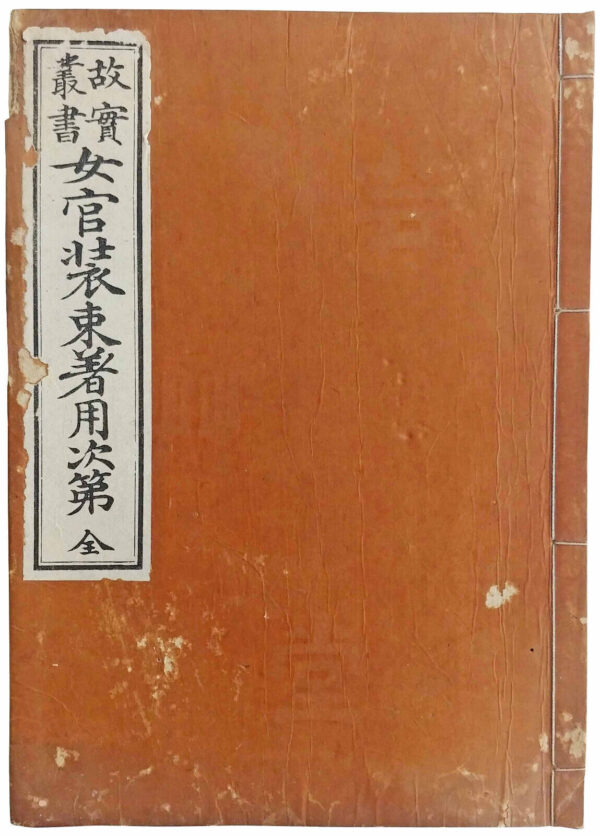
okan Syozoku Cyakuyo Sidai. Colour Illustrations of Japanese Noble Women’s Attires.
Imaizumi Sadasuke An outstanding work to illustrate the correct way for Japanese noblewomen to wear formal attire in the Japanese Court - the Nyokan's jyunihitoe, written by Imaizumi Sadasuke, a scholar of the Kokugaku movement which emphasized Japanese classical studies who evidently researched the works of the eighteenth century noble Heizo Sadatake Ise. Woodblock print. The complete work. 8vo. 1 volume, opening from left to right, 15 pages, with 14 woodcut images, all of which are beautifully hand-painted in full colour and captioned in margins. Text is in Japanese. In publisher's original brown paper boards, with title slip to front. Traditional karitoji binding ("semi-bound" meaning title page and contents without a book cover) string-stitched at spine, fukurotoji style ("bound-pocket" with folded leafs bound into spine), and opening from left to right. Volume measures approximately 18 x 25 x 0,5 cm. Chips and indication of burrowing to covers, otherwise in very good and original condition, a stellar work with vivid, meticulously coloured, woodcut illustration, internally crisp and clean. Striking woodcut illustrations of jyunihitoe - the official dress worn by female court officials and ladies-in-waiting of Imperial Japan, for approximately 1000 years from the Heian period to the Edo period, painted with meticulous detail to bring depth and vibrant colour. During the Heian period (794-1185) women could hold court offices of substantial responsibility, managing the affairs of the Emperor. Female palace attendants were employed by the Imperial Bureau of Palace Attendants from among the court aristocracy, but were required to have sufficient education in Chinese classics to be accepted. Women who held official positions and served in the Court of Japan from the Heian to the Edo period were called Nyokan (Nyobo, Kyujyo). The most famous is Murasaki Shikibu, who is considered the author of Tale of Genji. The imperial court offices were reserved for members of the court aristocracy and the ladies-in-waiting or 'palace attendants' were commonly educated members of the nobility. Female palace attendants were divided in two classes, which in turn had several ranks, signifying their task. The first class consisted of the nyokan, or ladies-in-waiting who held court offices: naishi-kami (shoji) naishi-suke (tenji) and naishi-no-jo (shoji). The second class were the female palace attendants: myobu, osashi, osue and nyoju. The ladies-in-waiting worked as personal assistants, tending to the Emperor's wardrobe, assisting the emperor's baths, serving meals, performing and attending court rituals. Ladies-in-waiting could be appointed as concubines, consorts or even Empresses by the Emperor or the heir to the throne. The function of a lady-in-waiting as potential concubine was abolished in 1924.- $975
- $975
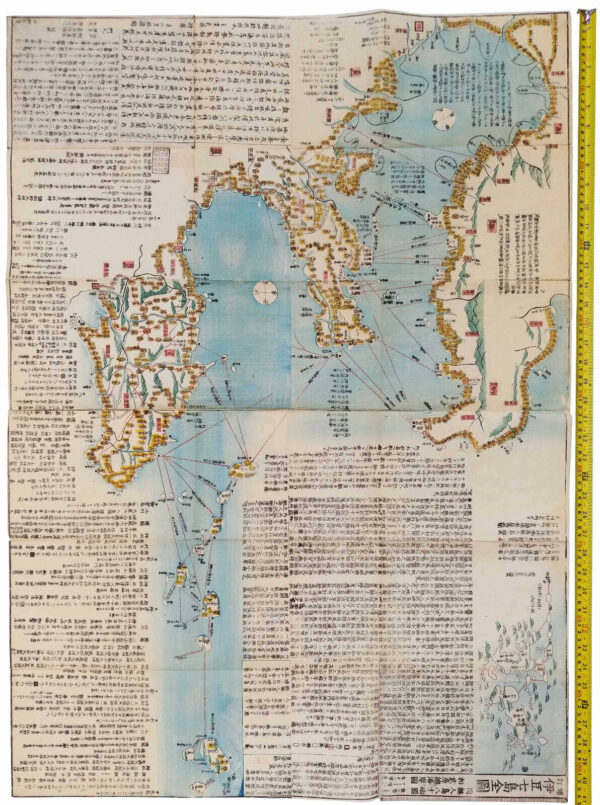
Large Woodcut Watercoloured Map Illustrating the Remote and Mostly Uninhabited Nanpo and Ogasawara Archipelagos
Tojo Kindai, Abe Rekisai, et al. English translation of map title: [The Complete Map of the Seven Islands of Izu with a Map of the Eighty Uninhabited Islands.] Large woodcut watercoloured map titled to illustrate the remote and mostly uninhabited Nanpo and Ogasawara archipelagos, lying some 1000 kilometers south of Tokyo, of the important and banned map produce jointly by scholar and official Tojo Kindai and Abe Rekisai, from a limited run of 500 maps printed in 1848, for private distribution, not for sale to the public owing to the Tempo reform which oppressed any interest in subject matters concerning Western interests (Hawaiians and westerners were inhabiting the island). Kindai was imprisoned and subsequently exiled from Edo for the publication of the map; Rekisai was a promoter of Japanese settlement of the Bonin islands and it appears that he may have been spared from persecution. Folded and mounted to two striped cardstock boards at two ends for neat storage, also giving it the appearance of a typical Japanese book for concealing the content. Title, legend, placenames, and detailed descriptions, are all in Japanese. Map measures approximately 105 x 76 cm, folding into sleeve for safe storage at approximately 25 x 18 cm. Some age-toning, title label to boards worn, reinforced to one fold, otherwise in very good condition, beautifully preserved, with lovely colour accents, extensive detail, and retianing a strong impression. A rare surviving woodcut map that was banned by the shogunate. Tojo Kindai (1795-1878) was a Confucian scholar, calligrapher and cartographer active in Edo, where he was born, during the mid-nineteenth century. He studied under Ota Kinjo and Kameda Pengsai, and later served the Fukushima Daimyo. His aim with the production of this map was to illustrate the strategic importance of the Bonin islands, but by doing so, revealed secret information, essentially information about Western civilians and their successful agragarian activites on the islands. Knowledge of western ways was strictly prohibited. He was gaoled for seven months, then exiled from Edo for eight years after producing the map, which centered on the coveted southern islands that would become Japan's first overseas colony only fourteen years later (still during his lifetime). Ironically, criminals in Edo were often confined on Hachijojima island (in which he clearly took interest) or Miyakejima of the nearby Izu island group, especially political prisoners such as Kindai would have been labeled. Abe Rekisai (1805-1870), also known as Abe Yoshito, Abe Tomonoshin, and Hashukuen, born in the Toshima District of Edo, was a Japanese botanist, herbalist and author who published many works, with subjects on horticulture, botany, and even social conflict resolution. In 1856 he published geographic descriptions of Hokkaido where Abe Sho nin, his ancestor, twice visited to collect medicinal plants, commissioned by the Shogunate government (Bakufu). A most fascinating map produced twenty years before Japan's Tokugawa (Edo) shogunate had claimed the Nanpo and Ogasawara archipelagos lying some 1000 kilometers south of Tokyo in 1862, the islands are named, and communication routes between them are clearly indicated. Mountain ranges are also shown, both on and around the islands. It was the height of the Tempo reform of 1841-1843 when Kindai first published the map, a highly risky endeavour with the economic and political reform that dealt a sweeping blow to the publishing industry. Resolute and unflappable, Kindai continued to seek out more information on the subject, and again printed a small number of his map, slightly revised, in 1848. It too, was banned by the shogunate, who undoubtedly gathered and destroyed all copies they could find, a common practice of the day, which yet again inspired and necessitated scholars to become clandestine transcribers of important works. For his map, now produced twice and deemed "an act of political agitation," Kindai found himself in violation of s- $2,750
- $2,750
Britain’s Cottons: Vintage Sample Box by the Cotton Board Home Trade Department.: https://rarebookinsider.com/rare-books/britains-cottons-vintage-sample-box-by-the-cotton-board-home-trade-department/
